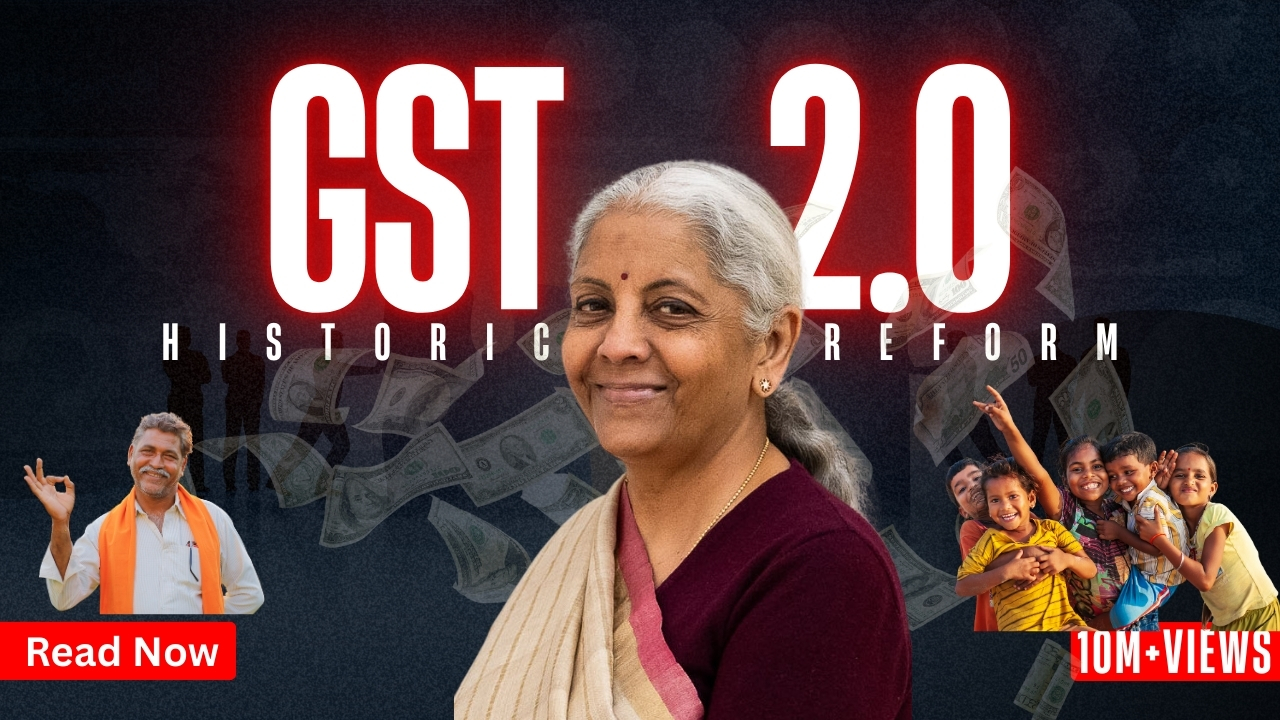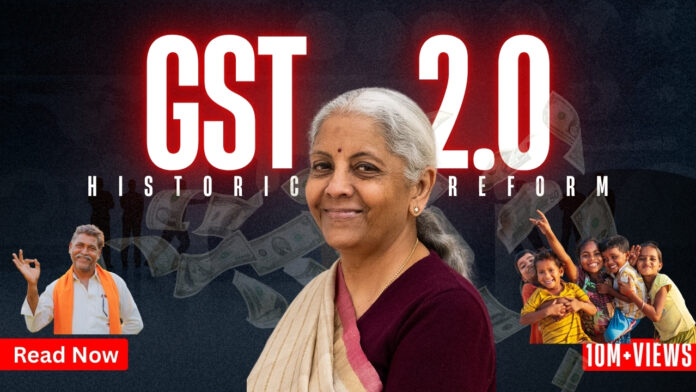
GST 2.0 brings new simplified tax slabs, empowering common people, farmers, and boosting Make in India. Learn why this reform is a game-changer for India.
Table of Contents
India has taken another major step in its economic journey with the approval of GST 2.0 by the GST Council. Finance Minister Nirmala Sitharaman has played a key role in this reform, which is being celebrated as a win for the common people, farmers, and small businesses. With the new simplified slabs, GST 2.0 promises to reduce the burden of taxation, make everyday goods cheaper, and give a strong push to the Make in India movement.
For years, India struggled under the complex and often unfair indirect tax system that varied from state to state. The introduction of the Goods and Services Tax (GST) in 2017 was a turning point, but it also had its challenges. Now, with GST 2.0, the government has shown its commitment to correcting the loopholes and ensuring that this tax regime truly works for the people of India.
In this blog, we will discuss what GST 2.0 is all about, how it helps common citizens, why farmers’ families are thankful, and why it’s being called a step toward empowering the poor. We will also compare it with the old tax system and explain why the opposition’s criticism doesn’t hold much ground.
https://bharatdiaries.com/tourism-for-foreigners-in-india-best-places-to-visit-in-september-2025/
GST 2.0: What Is New?
GST 2.0 is being described as the second phase of India’s tax revolution. The biggest highlight of this reform is the new simplified GST slabs. These changes have been introduced with the intention of making taxation fairer, more transparent, and less burdensome for the average citizen.
- Lower rates for essential goods: Daily-use products like food items, medicines, and household goods will now attract lower GST.
- Encouragement for local manufacturing: The new slabs favor Indian-made goods, boosting the Make in India initiative.
- Simplified compliance: Businesses, especially small and medium enterprises (SMEs), will benefit from easier filing and reduced paperwork.
- More revenue stability: While reducing the burden on the poor, the new system ensures steady revenue for the government to fund welfare schemes.
This balance between welfare and economic growth makes GST 2.0 a significant leap forward.
Why GST 2.0 Is Excellent for Common People
One of the biggest criticisms of the earlier GST structure was that it sometimes felt like a burden for middle-class families and small businesses. With GST 2.0, the government has tried to address this concern.
- Cheaper essential items – Food grains, cooking oil, and medicines now fall under lower slabs, giving relief to household budgets.
- Affordable housing – Construction material and basic housing services attract reduced GST, making homes more accessible.
- Support for small traders – Compliance rules have been relaxed, and digital filing has been made more user-friendly.
For example, a family in a small town buying groceries and medicines will now save more every month. These savings, though small individually, add up to a big relief for millions of Indian households.
Farmers’ Families and Rural India Benefit from GST 2.0
India’s economy depends on its farmers, and GST 2.0 ensures they are not left behind. Some of the major benefits include:
- Cheaper agricultural inputs: Fertilizers, seeds, and farming equipment now come under lower GST slabs. This reduces the cost of farming.
- Better income opportunities: By lowering taxes on food products and rural industries, farmers and rural entrepreneurs can earn more.
- Stronger rural infrastructure: Government revenue saved through simplified tax collection can be redirected to rural development projects.
For a farmer’s family in Punjab or Bihar, this means not only lower costs of cultivation but also better chances of selling produce at competitive prices.
GST 2.0 and Make in India
One of the most exciting aspects of GST 2.0 is how it supports Make in India, India’s flagship manufacturing initiative.
- Domestic goods get priority: Imported luxury goods face higher GST, encouraging people to buy Indian products.
- Ease for MSMEs: Small manufacturing units now have simpler compliance requirements, reducing their operating costs.
- Boost to exports: By rationalizing taxes, Indian-made goods become more competitive globally.
For example, a small textile unit in Surat can now focus more on production and less on navigating tax complications, making Indian fabrics cheaper for global markets.
Old Tax System vs GST vs GST 2.0
To understand why GST 2.0 is such a big deal, we need to look at the old tax system that existed before GST:
- Multiple taxes: Excise, VAT, service tax, entry tax, and more—each applied at different levels.
- Cascading effect: People often ended up paying tax on tax, making goods costlier.
- State-level complications: Each state had different rates, creating confusion for businesses.
GST (2017) simplified this by bringing most indirect taxes under one umbrella. However, there were still gaps and high rates in some areas.
Now, GST 2.0:
- Brings fewer, simpler slabs.
- Removes ambiguities for businesses.
- Makes the system fairer for the poor.
In short, GST 2.0 is the real reform people were waiting for.
Addressing Opposition Criticism
Opposition leaders have criticized GST 2.0, calling it “inadequate” or “politically motivated.” But when we compare the facts, these comments appear baseless.
- Reality check: The old tax system was far worse and more burdensome.
- Public opinion: Ordinary citizens, farmers, and small traders have largely welcomed the new slabs.
- Economic sense: Experts agree that rationalized taxation will strengthen India’s economy in the long run.
Instead of dismissing the reform, critics should appreciate that this change helps the very sections of society they claim to represent.
How GST 2.0 Empowers the Poor and Middle Class
One of the most powerful achievements of GST 2.0 is that it directly empowers the poor. This is not just about saving money but about building opportunities.
- More disposable income: Lower tax rates mean families can spend more on education, healthcare, and personal growth.
- Inclusive growth: By focusing on farmers and rural industries, GST 2.0 ensures India’s growth is not limited to urban elites.
- Job creation: The boost to MSMEs and manufacturing will open new employment opportunities.
Imagine a young graduate in a rural town. With local industries growing and goods becoming more affordable, they have better chances of finding work and improving their quality of life.
GST 2.0 and Digital India
The government has also tied GST 2.0 with Digital India. Online filing is now easier, fraud detection has improved, and compliance is less intimidating.
- Mobile-friendly filing: Even small shopkeepers can now file returns through mobile apps.
- Transparency: With digital monitoring, chances of tax evasion reduce.
- Empowered citizens: Digital tools mean less dependence on middlemen or consultants.
This not only modernizes India’s economy but also makes taxation more people-friendly.
Conclusion
The approval of GST 2.0 is nothing less than a landmark reform in India’s economic journey. By introducing simplified slabs, lowering rates on essentials, and focusing on farmers and local industries, the government has shown its commitment to empowering the poor and the middle class.
While critics may call it political, the reality is that common people, farmers, and small businesses are already experiencing relief and opportunities. GST 2.0 is not just a tax reform; it is a step toward inclusive growth, self-reliance, and a stronger India.
Finance Minister Nirmala Sitharaman and the government deserve appreciation for this bold step, which reflects the spirit of a new, self-confident India.
As India moves forward, GST 2.0 will be remembered as the reform that truly connected the tax system with the dreams of its people.
